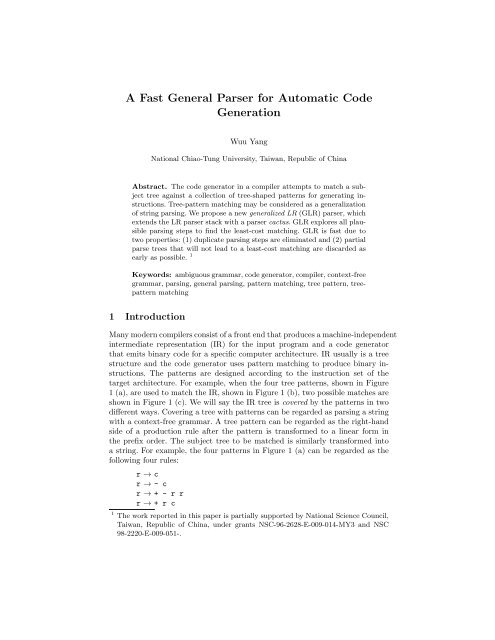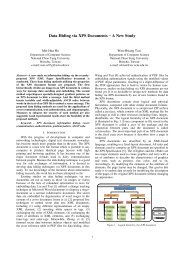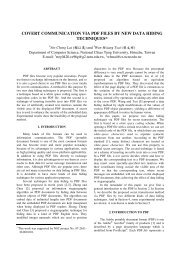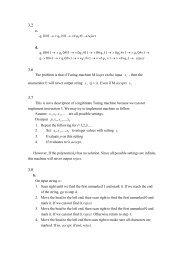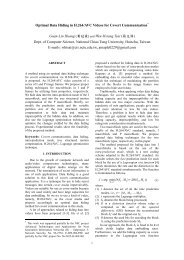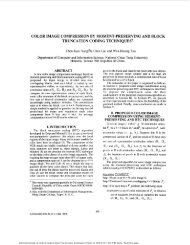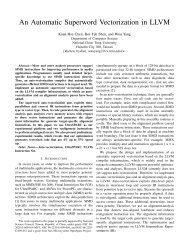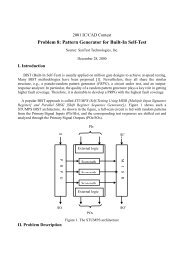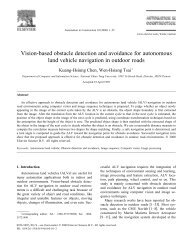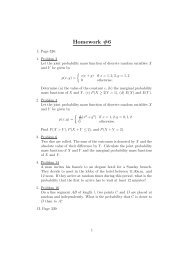A Fast General Parser for Automatic Code Generation
A Fast General Parser for Automatic Code Generation
A Fast General Parser for Automatic Code Generation
Create successful ePaper yourself
Turn your PDF publications into a flip-book with our unique Google optimized e-Paper software.
2Fig. 1. (a) Four tree patterns. (b) The IR tree. (c) Two covers <strong>for</strong> the subject tree in(b).Because tree patterns are derived from the instruction set, the resulting contextfreegrammar is called the instruction grammar. The subject tree in Figure 1(b) is trans<strong>for</strong>med into the string “+ + - c c c”, which will be parsed with theabove instruction grammar.For most popular processor architectures, their instruction grammars areoften ambiguous. That is, a task can usually be accomplished with two or moreinstruction sequences. The optimizer attempts to find the least-cost instructionsequence.Since the instruction grammars are usually ambiguous, a subject tree couldoften be covered in two or more ways. For instance, the subject tree in Figure1 (a) has two different covers according to the four tree patterns. We usuallyassociate a cost <strong>for</strong> each production rule. The cost of a cover is the sum ofthe costs of the production rules used in the cover. Then our objective is tofind the least-cost cover. For example, the Just-In-Time compiler in CVM [12]incorporates such a parser in its code generator.In this paper we present a general parsing algorithm that would decide theleast-cost cover. The algorithm, which is called the GLR parser, is a generalizedLR parer. It enumerates all plausible candidate parse trees. It also attempts toskip repeated parsing steps and to discard partial parse trees as soon as it isclear that a partial tree will not result in a least-cost cover.A sentence in an ambiguous grammar may have two or more parse trees.A straight<strong>for</strong>ward representation of multiple parse trees is a collection of independentparse trees. However, this tree-collection representation suffers twoweaknesses:
31. It wastes a lot of storage because the tree representations do not share commonparts.2. It does not highlight the differences between two parse trees.We propose a new representation <strong>for</strong> multiple parse trees <strong>for</strong> the same inputsentence. In the new representation, parse trees <strong>for</strong> the same input sentencewill share many nodes and their differences will be highlighted with specialalternative nodes. This new representation is built with a modified bottom-upparser. For example, Figure 2 (c) shows a composite tree that represents the twotrees in Figure 2 (a) and (b).The new representation is useful not only <strong>for</strong> ambiguous grammars. It is alsouseful <strong>for</strong> grammars that require a general parser. It is known that there aregrammars, though not ambiguous, that require a parser to keep track of morethan one potential derivation during parsing. For this kind of grammar, theparser needs to maintain multiple partial parse trees during parsing.The GLR parser proposed in this paper makes use of this new representationto parse its input. Its output is a composite parse tree that represents one ormore standard parse trees.The rest of this paper is organized as follows: Related work is discussed in thenext section. In Section 3, we will propose the general parser. We will show howto add the alternative nodes during parsing. In the last section, we will concludethis paper.2 Related WorkGlanville and Graham [8] makes use of a standard LR parser <strong>for</strong> the code generator.In contrast, we use a generalized LR parser. Their method resolves conflictsby favoring shorter instruction sequences. A shift operation is always preferredin case of a shift-reduce conflict. Reduce-reduce conflicts are resolved by thesemantic restrictions [9].Christopher et al. [3] also suggests the use of general parsers, such as Earley’sparser [4], to generate all possible parse trees and then to choose the one withthe least cost.Madhavan et al. [10, 11] allows only tree patterns whose heights are 2 but italso allows wildcards. Our algorithm does not impose such a restriction.Most code generation algorithms based on pattern matching relies on choosingthe least-cost match among all possible matches. Some cut down the searchspace with various heuristics [3].Because the instruction grammar is often ambiguous, some algorithms maynot always terminate. For example, Madhavan [10] (p. 9) also mentioned thattheir algorithm may not always terminate and consequently has to revert to dynamiccost computations. In our case, we can use a table of pairs (state, index).Whenever a repeating pair appears (which means cyclic derivation state 1 →state 2 → . . . → state 1 without actual progress in parsing), that branch can beabandoned without further exploration. This table can be implemented with ahash function.
4The optimization phase of a traditional compiler attempts to find the leastcostamong the equivalent instruction sequences. Many algorithms [8, 1, 6] makesuse dynamic programming to generate such an optimal instruction sequence.In our tree-pattern matching, we may adopt a parser that could enumerateall covers of a subject tree (efficiently) and the least-cost cover could be chosen.Earley’s parser [4] could be a candidate parser.If we use a general parser that could produce all possible covers <strong>for</strong> a subjecttree, the least-cost cover could be easily chosen. The processing time is essentiallythat of the general parsers, which is no more than O(n 3 ) <strong>for</strong> Earley’s parser. Onthe other hand, algorithms based on dynamic programming usually assume acontiguous execution property [1] in the original machine instruction.Aho et al. [1] constructs a finite state machine (similar to LR(0) machine)from the path strings. Our approach is similar to theirs.3 GLR(1) <strong>Parser</strong>sSimilar to an LR(1) parser, a GLR(1) parser consists of a goto table and an actiontable [2, 5]. Since we allow grammars with conflicts, an entry in the action tableis a set of shift and/or reduce actions. (Note that in an LR(1) action table, anentry is either a shift action or a reduce action. No conflicts are allowed.) Thegoto table in the GLR(1) parser still encodes the LR(1) finite-state machine.The parser stack in an LR(1) parser is implemented as an ordered list of entries.In contrast, the GLR parser is equipped with a parser cactus, which representsseveral parser stacks simultaneously. (A cactus is actually a tree structure.We choose the word “cactus” in order to avoid confusion with the term parsetrees widely used in the parsing theory.) A path from the root to a leaf in theparser cactus represents a parser stack. Each parser stack in the cactus denotesa possible parsing process.A node in the parser cactus corresponds to an entry in the traditional parserstack. The nodes are linked together with pointers. A leaf node denotes the topof a stack. A push operation is implemented as adding a node to a leaf; a popoperation is implemented as <strong>for</strong>king a new node at the appropriate node. Allthe leaf nodes are collected in the Frontier set. (In the algorithm below, we willleave popped nodes in the cactus in order to simplify the algorithm.)The input string, which is the pre-order traversal of the subject tree, is storedin an 1-dimensional array input.When a node A is added to the children set of another node B, we assumethat there is an implicit pointer stored A that points to B. We do not showthis pointer the following algorithm. See lines 17 and 28 in the GLR parsingalgorithm below.A node denotes an entry in the parse stack, which is declared as follows:recordstate: an LR(1) stateindex: the position of the input symbol at this state
5children: the set of child nodesend recordA node’s state is the parser state when the node is on the top of the parse stack.A node’s index is the position of the input symbol when the node is on the topof the parse stack. A node’s children is the set of all children of the node in thecactus. The children field is always initialized as the empty set when a node isallocated.In line 22 in the GLR parsing algorithm below, we used the term m-th ancestor,which is defined as follows: a node’s parent in the cactus is the 1st ancestorof that node; the parent of a node’s parent is the 2nd ancestor of that node; etc.In LR parsing, to pop off m symbols from the stack is to locate the m-th ancestorof the stack-top node in the cactus. In order to accommodate λ-productions, wefollow the convention that the 0-th ancestor of a node is the node itself.Algorithm GLR parser1. allocate a new node Root;2. Root.state := start state;3. Root.index := 1;4. Root.children := { }; /* an empty set initially */5. F rontier := {Root }; /* a set consisting of a single node */6. Accepted := { }; /* an empty set initially */7. while F rontier is not empty do {8. x := pick the first node from F rontier;9. F rontier := F rontier − {x};10. <strong>for</strong> each action actn in action(x.state, input[x.index]) do {11. switch(actn) {12. case shift:13. allocate a new node N;14. N.state := goto(x.state, input[x.index]);15. N.index := x.index + 1;16. N.children := { };17. x.children := x.children ∪ {N};18. F rontier := F rontier ∪ {N};19. break;20. case reduce i:21. m := length of the right-hand side of rule i;22. s := the m-th ancestor of node x;23. t := left-hand-side nonterminal of rule i;24. allocate a new node N;25. N.state := goto(s.state, t);26. N.index := x.index; /* do not consume input. */27. N.children := { };28. s.children := s.children ∪ {N};/* <strong>for</strong>k a new child */29. F rontier := F rontier ∪ {N};30. break;31. case accept:
632. Accepted := Accepted ∪ {x};33. break;34. case error: /* simply throw away the node x. */35. } /* end of switch */36. } /* end of the <strong>for</strong> loop */37. } /* end of the while loop */After the GLR parser terminates, each node in the Accepted set correspondsto a derivation, which is a cover of the subject tree with the given tree patterns.If the Accepted set is empty, the input string cannot be generated from the grammar.This means that the subject tree cannot be covered by the tree-patterns.Fig. 2. Two parse trees <strong>for</strong> the sample input uxyv.Example. Consider the following (ambiguous) grammar:S → A B CA → uC → vB → P yB → Q yP → xQ → xFigure 2 (a) and (b) shows two parse trees <strong>for</strong> the input uxyv. Figure 2 (c) showsthe composite parse tree. The square node “Alt(B)” means that there are twocandidates <strong>for</strong> the subtree rooted at B. Figure 3 shows the parsing steps <strong>for</strong> the
7input uxyv. Node N0 contains the initial state Init. The first three steps areshift, reduce, and shift, respectively. At steps d and e, the terminal x is reducedto P and Q, respectively. There are two branches (i.e., two stacks) on the parsecactus at this step. At steps f and g, a shift operation is per<strong>for</strong>med on each ofthe two stacks. At steps h and i, a reduce operation is per<strong>for</strong>med on each ofthe two stacks. Note that at step i, the new node—N9—and the existing nodeN8 are combined together (thus creating the alternative node N10) becausethey both contain the same parser state and they represent the same segment ofthe input (that is, the segment xy). The subtree stored in node N10 is shown inFigure 2 (d). Afterwards, v is shifted into the stack and then is reduced to thenonterminal C. Finally, the sentential <strong>for</strong>m ABC is reduced to the start symbolS. The tree stored in node N13 is the complete composite parse tree, which isshown in Figure 2 (c). ✷Fig. 3. The parser cactus during the parsing steps. N0 is the initial state Init.
8There are several assumptions in the above algorithm: First, we assume nodesin the Frontier set are ordered by their index fields. When a node N is addedto Frontier (in line 18 and line 29), it is implicitly assumed to be inserted tocorrect place in Frontier. Thus, in line 8, “pick the first node from Frontier”, anode with the smallest index field is picked up.3.1 Introducing the alternative nodesThe above algorithm demonstrates only the parsing part. A collection of parsetrees can be built during parsing, as follows. Every node in the cactus containsthe subtree rooted at that node. When a shift operation is per<strong>for</strong>med (in line12), the new node contains a tree that has the newly shifted terminal symbolonly. When a reduce operation is per<strong>for</strong>med (in line 20), a tree is created whoseroot is the nonterminal t (in line 23) and whose children are the m popped-offnodes. This tree is stored in the new node N (line 24).When a reduce operation is per<strong>for</strong>med, a new node is created. Be<strong>for</strong>e <strong>for</strong>king anew branch, we check if the new node has a sibling that contains the same parserstate and represents the same segment of the input. If so, the two nodes will becombined together and a new alternative node will be created to representthe two nodes. We will introduce the following definition:Definition. Two nodes in the parser cactus are called twins if they satisfy thefollowing three conditions:1. They are siblings, i.e., they have the same parent in the cactus.2. They represent the same segment of input.3. They are in the same parser state.The second condition is easy to evaluate since nodes in the Frontier set is orderedby their input positions (i.e., indices). The other two conditions are also easy toevaluate.Twins can be combined into an alternative node. For example, in Figure 3(i), nodes N8 and N9 are twins because they contains the same state and representsthe same segment of the input (that is, xy). Thus, N8 and N9 are combined,creating the node N10, which is an alternative node, shown in Figure 3 (j).The node N10 contains the subtree shown in Figure 2 (d). Combining two nodesmeans that further derivations from the two nodes are identical. Parsing time isalso reduced by avoiding repeated derivations.The alternative nodes are effective in that the conflicts in the instructiongrammars are usually restricted to certain subtrees. Even though a subject treemay have more than one cover, these covers share many common nodes. Thealternative nodes can reduce memory usage and the parsing time.3.2 Eliminating ineligible parser stacksWe will also add a cost field to every node. The cost of a leaf node is 0. Whena reduce i action is per<strong>for</strong>med (line 20), the cost of a newly allocated node N
9is the sum of the cost of the m nodes corresponding to the right-hand side ofproduction i plus the cost of production i. The cost of a production rule is definedby the tree-pattern designer. The cost could indicate the number of registers usedin the subtree, the number of instructions generated <strong>for</strong> the subtree, the numberof memory accesses needed during the execution of the instructions translatedfrom from the subtree, or the execution time <strong>for</strong> subtree, etc. The computationof the cost can be <strong>for</strong>mally specified with an attribute grammar, with a singlesynthesized attribute cost.In a code generator, we are interested in the least-cost parse tree(s). All otherparse trees are discarded. In the GLR parser, we can remove a parse tree be<strong>for</strong>eit is completely built. After we have decided two nodes are twins, instead ofcombining them, the one with the larger cost can be deleted immediately, savingthe time and space required <strong>for</strong> further exploration.Note that, in an ambiguous grammar, an input sentence may have an infinitenumber of parse trees. This is due to recursive null productions, as follows:A → BB → AB → λBy adding the additional requirement that the cost of a production rule is alwayspositive, the GLR parser will always terminate when the cost is more than thatof the currently optimal parse trees.4 ConclusionThe code generator is an important component in a compiler. Pattern matchingis frequently used to cover a subject tree with patterns in a code generator. Treepattern matching can be regarded as a general parsing problem, with an oftenambiguous instruction grammar. We designed a general parsing algorithm thatcan find a least-cost cover <strong>for</strong> a subject tree. We also developed a data structurethat can represent multiple parse trees.References1. A.V. Aho, M. Ganapathi, and S.W.K. Tjian, “<strong>Code</strong> <strong>Generation</strong> Using Tree Matchingand Dynamic Programming,” ACM Transactions on Programming Languagesand Systems, 11, 4, October 1989, pp 491-516.2. A.V. Aho, M.S. Lam, R. Sethi, J.D. Ullman, Compilers, Principles, Techniques,and Tools, 2nd ed., Addison-Wesley, New York, 2007.3. T.W. Christopher, Philip J. Hatcher, Ronald C. Kukuk, “Using Dynamic Programmingto Generate Optimized <strong>Code</strong> in a Graham-Glanville-Style <strong>Code</strong> Generator,”In Proceedings of the 1984 SIGPLAN symposium on Compiler construction, ACMSIGPLAN Notices 84, ACM, New York, 1984, pp. 25-36.4. J. Earley, “An efficient context-free parsing algorithm,” Comm. ACM, 13, 2, February1970, pp. 94-102.
105. C.N. Fischer and R.J. LeBlanc, Jr., Crafting a Compiler with C, Benjamin/Cummings,Reading, MA, 1991.6. C.W. Fraser, D.R. Hanson, and T.A. Proebsting “Engineering a Simple, Efficient<strong>Code</strong> Generator Generator,” ACM Letters on Programming Languages and Systems,Vol. 1, No. 3, September 1992, pp. 213-226.7. R. S. Glanville, A machine independent algorithm <strong>for</strong> code generation and its usein retargetable compilers. Ph.D. dissertation, University of Cali<strong>for</strong>nia, Berkeley,Dec. 1977.8. R. Steven Glanville and Susan L. Graham, “A new method <strong>for</strong> compiler code generation,”in Proceedings of 5th ACM SIGACT-SIGPLAN Symposium on Principlesof Programming Languages (Tucson, Arizona), 1978, pp. 231-254.9. R. Nigel Horspool, “An Alternative to the Graham-Glanville <strong>Code</strong>-<strong>Generation</strong>Method,” IEEE Computers, Vol. 20, May 1987, pp. 33-39.10. M. Madhavan and P. Shankar, “Optimal regular tree pattern matching using pushdownautomata,” in 18th Conference on Foundations of Software Technology andTheoretical Computer Science, December 17-19, 1998, Chennai, India, pp. 122-133.11. M. Madhavan, P. Shankar, S. Rai, and U. Ramakrishna, “Extending Graham-Glanville Techniques <strong>for</strong> Optimal <strong>Code</strong> <strong>Generation</strong>,” ACM Transactions on ProgrammingLanguages and Systems, 22, 6, November 2000, 973-1001.12. Sun Microsystems, Connected, Limited Device Configuration, Specification Version1.0a, Java 2 Plat<strong>for</strong>m Micro Edition 1.0a, May 19, 2000, CA, USA.


